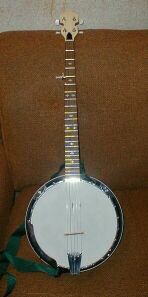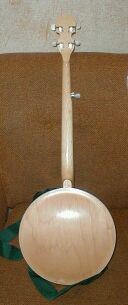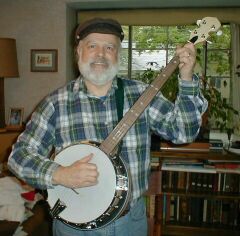
|

|
|
|
|
Since I first published this page in mid 2003,
I have put a few miles on this banjo. So, now in
early 2005 I have performed a major tuneup on it.
For the details, click here.
But if you have not read this summary yet,
do that first. B.S.K. - March 2005 |
The banjo is now finished. Here are some photos of it from the front and the back:

|

|
And, finally, here is a photo of your happy trail guide with his new banjo:

Please keep in mind as I compare the Maple Classic to my other banjos that the three instruments reside in different strata as far as cost goes. I paid $200.00 for my Goodtime (used) completely built and playable with a gigbag and an armrest and a strap..... My Bart Reiter cost me close to $1,000.00 including the case (but no arm rest or strap). So, the Maple Classic kit, which cost me $300.00, falls nicely between the two other banjos. I would not expect these three banjos to be equals, and I mean no disrespect to any of them with the comparisons.
Here is my summary of the Maple Classic Banjo as a kit and as a banjo.
The advertisements say "No special tools", and that is mostly true. I did have to find some tools that I would not normally have lying around the house, such as a 12 inch long drill bit, but there was nothing required that was difficult to find or terribly expensive (such as a lathe or a drill press). The only tool that was not available was a 5th string peg reamer, but I did just fine without it. I did use some tools that most folks might not have, such as my fret saw (which is thinner than a coping saw blade) and my scribing tool (which I used to mark the shoe height on the pot). However, I am sure that substitues could be found to do the things that I did with those.
My general observations are that the Goldtone Maple Classic is a very nice banjo. The parts are of higher quality than I had expected for the price I paid. And while there were some small problems with the kit, such as missing parts, the people at Goldtone were very helpful and quick to correct them.
The hooks on the banjo are solid. They are not cheap, sheet metal affairs as they are on some cheap banjos. The 1/4 inch nuts seem a bit wimpy compared to the 5/16th inch nuts on my Reiter. But they work fine with no signs of being over stressed.
The shoes are real shoes, which are better than the hex bolts that are on the Goodtime. The pointed shape of the shoes provides better leverage against the head tension than the simple hex bolts do.
The Price licensed tailpiece is nice. Since the strings come off the bridge straight back instead of at an angle, I had no problems with them slipping out of the notches as I brought them up to tension. This allowed me to set the notches on the bridge for action and sound and not have to deepen them to correct for an angular pull on the backs of the strings. It is a solid tailpiece, and it went in easily.
The tuners seem to be high quality sealed guitar tuners. So far they have been very solid and have held a tuning well.
The nut looks like it is made of plastic instead of bone (as stated in the promos). But I cannot state this for certain. It just seems to be soft for bone, and I could see no grain in it. But it works fine.
The "snowflake" inlays are nice. They are very nicely inlaid into the fingerboard. The word "snowflake" is in quotes because they really are diamond shaped inlays with some kind of coloring or carving on the underside to make them look more complex than they are. However, the illusion is perfect, and the neck is beautiful. I am really amazed at the nice shape, the straightness, and the quality of the handwork on this neck.
One thing that I really appreciate about the neck is that it has side dots. All of my openbacks have no side dots, and it is certainly difficult to see the inlays on the finger board while playing.
The neck is more delicate than the Reiter neck, but more substantial than the Goodtime neck. The tuners on the Maple Classic are better than the open geared tuners on the Goodtime, but they are not pegs like the ones on the Reiter. Pegs would be nice, but I could not justify the added expense.
The shape of the peghead on the Maple Classic is very nice; much better than the shape on the Goodtime. But I like the shape of my Reiter peghead the best.
This banjo seems more substantial than my Goodtime, but then the Goodtime is an openback with no tone ring and no resonator. It is also a bit heavier than the Reiter, which also has no tone ring and no resonator.
I have no previous experience with resonator banjos, so I cannot compare the sound of this one with other resonator banjos. In comparison to my openbacks, it plays at least as easily. It is a bit louder (probably due to the resonator) and has a bit more sustain (probably due to the tone ring).
The finish is beautiful (kudos to me). The action of the strings is nice and low, making it fret in tune up the neck (also kudos to me). The third string plays slightly sharp in the middle frets, which means that it might benefit from some delicate compensation at the bridge. But it is good enough already that I will not worry about that until I have some more time playing it.
The veneer on the Maple Classic peghead is very very white. It has a bit of curl in it, which is nice, but its color is so pale, that it stands out even in comparison with the color of the maple used for the neck, pot, and resonator. This looks a bit strange to me, but it is not a major problem.
If I would find a fault with the kit, it would be in the minimal instructions which came with it. I have built banjo kits before, so I was able to fill in the details from my past mistakes. However, a complete novice might become lost while attempting to follow the instructions with this kit, especially in the part concerning the setup of the banjo. This is not to say that you should not attempt to build this kit as a novice. There are several message boards on the web where you can get help on the details. I can only hope that these pages will be of some use to you if you want to try this.
I will not be trading in my Goodtime or my Bart Reiter any time soon. Each has its own charms, but all-in-all I like the Goldtone Maple Classic banjo very much, and I am glad that I built it. It feels and sounds nicer to me each time I play it. Now, where did I leave those finger picks?
If I had to pay my auto mechanic to do this work at his current rate (in 2003 dollars), the banjo would have cost me $300.00 for the parts and $2052.00 in labor. That adds up to $2352.00. I suspect that I could purchase a completed banjo for that much money which would be of considerably higher quality and performance than this one.
However, my auto mechanic did not make this banjo, I did. And the experience I gained from doing this work is certainly worth a lot to me. So viewing the project from a different point of view, I bought an introductory workshop in banjo luthiery for $300.00 plus some weekends to study......... and I get to keep the banjo that I built in the bargain. Not a bad deal in anybody's book.